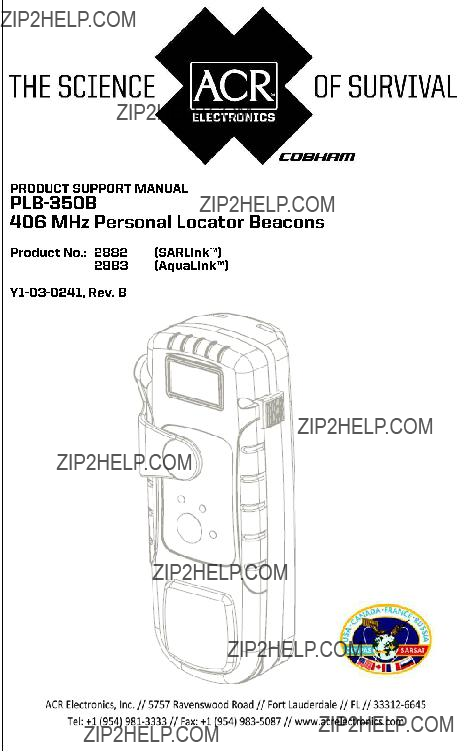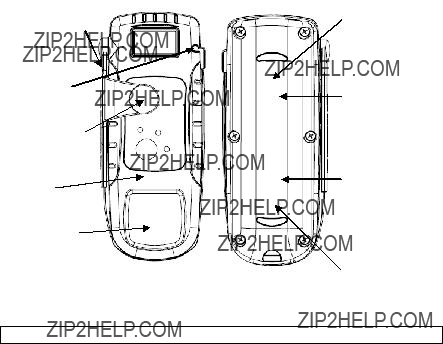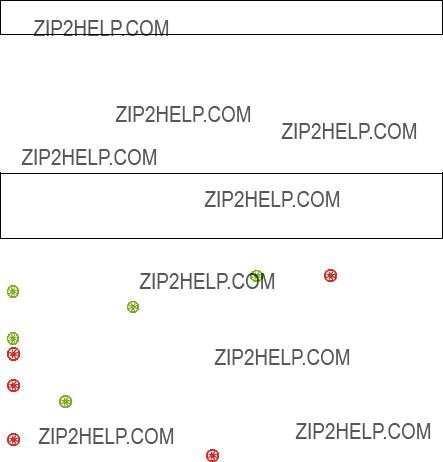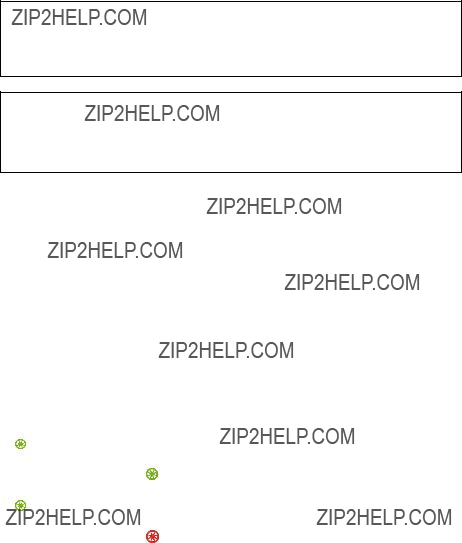


About Cobham Life Support, ACR Products
Cobham Life Support, ACR Products www.acrelectronics.com, designs and manufactures a complete line of safety and survival products including EPIRBs, PLBs, AIS, SARTs, Strobe Lights, Life Jacket Lights, Search Lights and safety accessories. The quality systems of this facility have been registered by UL to the ISO 9001:2000 Series Standards. Recognized as the world leader in safety and survival technologies, ACR has provided safety equipment to the aviation and marine industries as well as to the military since 1956.
About Cobham plc
Cobham plc is an international company engaged in the development, delivery and support of advanced aerospace and defense systems for land, sea, air and space. The company has four divisions that collectively specialize in the provision of components, subsystems and services that keep people safe, improve communications and enhance the capability of aerospace and defense platforms.
CAUTION: Before proceeding to install, test or use your new
ACR Electronics??? product, please read this Product Support Manual in its entirety.
If you have questions regarding the contents of the manual or something not covered in the manual, please contact our Technical Service Department at ACR Electronics, Inc., Telephone +1 (954)
 PLEASE READ ALL WARNINGS,
PLEASE READ ALL WARNINGS,
CAUTIONS AND NOTES CAREFULLY

Table of Contents
STEP ONE - REGISTERING YOUR BEACON _____________________ 3 STEP TWO - HOW THE BEACON WORKS ______________________ 5 STEP THREE - MAINTAINING YOUR PLB______________________ 13
APPENDIX A - ACCESSORIES _______________________________ 16 APPENDIX B - THE
NOTE re: Applicable products
This manual supports all configurations of

STEP ONE - REGISTERING YOUR BEACON
Why is registration important?
As the owner of this 406 MHz beacon, it is mandatory that you register it with the PLB national authority of your country: It is the law. Please
note that all 406 MHz beacons are required to have their registration updated every two years by the owner.
HOW REGISTRATION WORKS:
All 406 MHz beacons transmit a Unique Identifier Number (UIN) when activated. This UIN is programmed into the beacon based on the country in which the beacon is registered, thus authorities are able to determine which country???s database will have your registration information. SAR forces will have information as to who you are as the owner of the beacon, the name and type of vessel that you have (if applicable), your address, and who to contact that might know of your current situation - but only if your beacon has been properly registered. Valuable search and rescue resources are wasted every year responding to false alerts, and registering your beacon helps to resolve this quickly.

What country should I register in?
Register your beacon with the PLB national authority of the country for which the beacon was programmed, typically the country where purchased, regardless of where you live or do your adventuring.
The beacon must be reprogrammed if you, as the owner, move out of the country where the beacon is registered. To verify the country for which a beacon is programmed, see the label with the UIN (Unique Identification Number) on the back of the unit. Units that do not have a country specified on the UIN label are programmed for the United States.
How do I register?
Registration in the United States
The national authority that accepts registrations in the United States is the National Oceanic and Atmospheric Administration (NOAA).
There are three ways to register:
1.The fastest and easiest way to register is online at www.beaconregistration.noaa.gov/.
2.Faxing a registration is also acceptable. Fax the registration form to the fax number on the top of the registration form.
NOTE: Do not confuse the registration form with the ACR Electronics warranty card.
3. If online or fax registration is not available, mail the registration form with the
Registration NOAA/NESDIS
NSOF, E/SP3
4231 Suitland Road
Suitland, MD 20746
All registration forms will be entered in the 406 MHz beacon registration database within 48 hours of receipt. The information you provide on the registration form is used for rescue purposes only.
A confirmation letter, a copy of the actual registration and a
Registration in Canada
The national authority in Canada is the NSS (National Search & Rescue Secretariat). Canadian residents can register online at http://beacons.nss.gc.ca/. For more information please contact the NSS at +1 (613)
Canadian Beacon Registry
CFB Trenton, PO Box 1000 Stn Forces
Astra, Ontario K0K 3W0
Registration in Other Countries
In countries other than the United States and Canada, 406 MHz beacons are registered with that country???s national authority at the time of purchase. The sales agent may have assisted you in filling out the forms and sending them to the country???s national authority. Alternatively, many countries allow online registration in the International 406 MHz Beacon Registration Database (IBRD) at www.406registration.com.
To verify that the unit is properly programmed for your country, view the UIN label on the back of the unit. In the event that the beacon is not programmed for your country, the sales agent (if properly equipped) can reprogram the unit for the correct country.
STEP TWO - HOW THE BEACON WORKS
1. How your beacon brings help
406 MHz beacons are a type of portable emergency equipment that transmits a distress signal to search and rescue (SAR) organizations. The purpose of these beacons is to aid SAR teams in tracking and locating ships or individuals in jeopardy as rapidly as possible.
The 406 MHz frequency is a worldwide dedicated emergency frequency that is detected by a network of satellites called the
When a 406 MHz beacon is activated, the digital distress message is sent to
The 406 MHz signal is detected by multiple satellites and from that information the location of the beacon can be calculated. This data alone is sufficient for SAR to find persons or ships in distress in a reasonable timeframe. However, as a further enhancement, some beacons have a GPS engine onboard. This feature allows the beacon to acquire current location coordinates from an internal GPS receiver. The purpose of this feature is to send an even more precise location of the beacon to the satellites, i.e., latitude and longitude data. This helps SAR to reach the location even faster.
2. Internal GPS position system
The
When the beacon is activated, the internal GPS immediately attempts to acquire positional coordinates. GPS coordinates can be acquired any time that the GPS is on, but only valid data is saved. Once the beacon acquires valid coordinates, the data is included as part of the next transmitted 406 MHz digital message.
The internal GPS operates on a schedule during a beacon activation. The GPS is on for a time, actively acquiring coordinates, and off for a time, in a standby state. The schedule is designed to conserve battery but, at the same time, assure that navigational coordinates are regularly updated.

3. Anatomy of your beacon
Figure 1
NOTE: The appearance of your beacon may vary from this picture.

4. Distinguishing PLB Features
The distinguishing features available on your PLB vary with the particular model that you selected. The following table summarizes the similarities and differences in models.
5. Activating your beacon
 WARNING: This transmitter is authorized for use only during situations of grave and imminent danger. Deliberate misuse may incur a severe penalty.
WARNING: This transmitter is authorized for use only during situations of grave and imminent danger. Deliberate misuse may incur a severe penalty.
Overview
Personal Locator Beacons are designed to be manually activated. They are only to be activated when all other means of

NOTE: The appearance of your key pad may vary from this picture.
ON / OFF Button (visible only when antenna is deployed)
GPS Test Button
Activation
 diagram
diagram
When activated:
 (Red LED) transmitting 406 MHz during activation
(Red LED) transmitting 406 MHz during activation
(Green LED) 406 MHz includes GPS data
NOTE: If you notice the PLB is flashing the red or green LED and
???beeping??? periodically on its own, this likely means it has accidentally been activated and needs to be shut off and reported as a false alert (see page 12).

6. Activation (406 MHz and 121.5 MHz)
To activate your beacon in a distress situation, follow these steps (see Figure 3 below).
1)Unfasten the antenna from the case.
2)Move it into the upright position
3)Depress the ON/OFF (  ) button for 1 full second.
) button for 1 full second.
You will hear a ???beep??? and your beacon is now activated. While transmitting your distress signal, the red LED will flash once every 2 seconds, alerting you that your beacon is active. An additional ???beep??? will sound every time your beacon transmits data to the satellites (roughly every 50 seconds).
???
???
 ???
???
Figure 3
7. 406 MHz/121.5 MHz antenna position
For maximum performance you must deploy the beacon antenna into the proper position as shown in Figure 3. If at all possible, be sure the antenna is positioned facing the sky and avoid submerging in water. This device is intended to operate on or above the ground or while attached to your person above the water line.
8. Activation with GPS
If your unit is activated, the GPS receiver will start up, search to find your LAT/LON and incorporate it into your 406 MHz signal. As soon as the GPS receiver acquires valid positioning data, the red LED will stop blinking and the green LED will begin flashing once every 2 seconds.
The same GPS data will be sent with each 406 MHz signal for the next twenty minutes. At that time the internal GPS will start up again, search to find your LAT/LON and incorporate it into your next 406 MHz signal. If for any reason the internal GPS cannot update your LAT/LON, your last position will be used for the next four hours. At that time the green LED

will stop blinking and the red LED will flash once every 2 seconds until new GPS data is obtained.
9. GPS receiver orientation
When activated, it is critical that you do not cover the beacon with any body part, water, clothing, etc. The GPS receiver is located under the bottom portion of the case behind the product logo (see Figure 4).
To ensure optimum performance of the GPS receiver, the beacon needs to have an unobstructed view of the sky. Avoid submerging the GPS receiver in water if possible. Water will shield and inhibit the GPS receiver and may cause difficulties obtaining your GPS coordinates. Avoid leaning over the beacon to view blinking LED as you may shield the GPS reception.
Figure 4 ??? GPS Receiver Location
10. Turning off the beacon
To deactivate your beacon, depress the ON/OFF (  ) button for 1 second.
) button for 1 second.
Once the beacon is deactivated, all blinking LED???s will stop, signifying that the beacon is no longer sending your distress message.
If deactivation should fail, remove the six screws holding the unit together and unplug the battery to disable the unit. Return the beacon to ACR Electronics for service.
NOTE: Leave beacon on until rescued. Turning beacon off will prolong or prevent rescue. Repeated activations could be viewed as a hoax.

11. Preventing false alerts
A false alert is any activation of the beacon, intentional or otherwise, that does not result from a situation of grave and imminent danger.
Be sure to do the following to help minimize false alerts:
Register your beacon. This does not reduce false alert rates; however, when the beacon is properly registered, the situation can usually be resolved with a phone call.
Be careful with whom you leave your beacon. Make sure that they know how to use it, and that they understand the ramifications of causing a false alert. A lot of false alerts are generated by curious individuals. If you notice the beacon is flashing the red or green LED and ???beeping??? periodically on its own, this likely means it has accidentally been activated and needs to be shut off and reported.
Do not stow beacon while other gear is in contact with the keypad.
The
NOTE: If you report a false alert and the authorities have not received the signal, do not be concerned. This may mean that you were able to deactivate the beacon before transmitting the signal.
12. False alert
A false alert must be reported to the search and rescue authorities.
False alerts in the US that are rectified must be reported to the US Air Force Rescue Coordination Center (AFRCC) to let them know that the situation has been corrected and everything is fine. Responsibly reporting these events to the AFRCC or your proper authority will not incur a penalty, but deliberate misuse or not notifying the proper authority may incur a severe penalty.
Reporting
Should there be a false alert for any reason, it must be reported to the nearest search and rescue authorities. The information that should be reported includes:
//The PLB
//Time and date
//Duration and cause of activation
//Location of beacon at the time of activation
To report false alert in the United States, contact the AFRCC:

To report false alerts outside of the USA, contact the national
authority where your beacon is registered.
STEP THREE - MAINTAINING YOUR PLB
1. Routine Maintenance
Carefully inspect the beacon case for any visible cracks. Cracks may admit moisture, which could falsely activate the beacon or otherwise cause a malfunction. Any cracks observed should be immediately referred to ACR for evaluation by calling +1 (954)
After checking the beacon case for cracks, it may be wiped down with a clean, damp cloth. Do not use any type of cleaner on your beacon.
2. Battery Replacement
Replace the battery no later than 6 years from date of manufacture, 5 years from date of install, or after emergency use. At each inspection, check the time remaining until replacement is required. The battery should be replaced if the beacon has been activated for any use other than the
NOTE: There are no user serviceable items inside the beacon. DO NOT OPEN THE BEACON. Opening the beacon will void the warranty.
For the nearest location of a Battery Replacement Center, visit our website at www.acrelectronics.com. Click on ???Support???.
This beacon contains 2 Lithium Metal Battery Packs that are less than 2 grams each. They are not classified as Hazmat for transportation. Prior to shipping beacon for service, alert your carrier about the batteries contained in this equipment to make sure they properly label your package. Call ACR???s Technical Service department at +1 (954) 981- 3333 for proper shipping instructions or visit the ACR website in the Support section entitled ???Hazmat, MSDS Sheets, & Info???.
3.
ACR strongly recommends performing a

A  or
or  ) for at least 1 second and less than 5 seconds. Your beacon will sound an initial ???beep??? and flash the green LED to signify the test has begun. The green LED will flash a second time to indicate that the self test was successful.
) for at least 1 second and less than 5 seconds. Your beacon will sound an initial ???beep??? and flash the green LED to signify the test has begun. The green LED will flash a second time to indicate that the self test was successful.
NOTE: The ???beep??? is a very high pitch that some people are unable to hear. Watching the LEDs may be more useful to you.
Components Tested: Data integrity and memory, 406 MHz synthesizer, RF power/battery, GPS header (if equipped).
If a red LED flashes at the completion of the
NOTE: During a
4. Battery witness seal failure
If your beacon flashes an initial red LED at the beginning of the Self- test, this indicates that your electronic witness has been broken and you have used more than the allotted battery life for

5. GPS acquisition test
This test is NOT required as 100% of all GPS receivers that leave ACR have been tested to ensure they perform correctly. However, if you would like to ensure your GPS receiver is working, please follow these instructions very closely.
 CAUTION: The following test should not be performed more than twelve times during the life of the battery pack. Once this GPS testing feature reaches 12 times, the feature will be disabled by internal software until the battery is replaced.
CAUTION: The following test should not be performed more than twelve times during the life of the battery pack. Once this GPS testing feature reaches 12 times, the feature will be disabled by internal software until the battery is replaced.
NOTE: The GPS receiver is located under the bottom front portion of the case. It is imperative that the receiver is not obstructed during
Press the
6. Changing ownership or contact information
As the owner of the beacon, it is your responsibility to advise the national authority of any change in your registration information. If you are transferring the beacon to a new owner, you are required to inform the national authority. You can do this by using their online database or by

letter, fax or telephone and informing the authority of the name and address of the new owner.
The new owner of the beacon is required to provide the national authority with all of the information requested on the registration form. This obligation transfers to all subsequent owners. See step 1, page 3 for further details on this process.
7. Lost or stolen PLBs
If your PLB is lost or stolen, do the following immediately:
//Report to your local authorities that the PLB has been lost or stolen
//Contact NOAA at (888)
o Police department name
o Police department phone number
o Police case number
If your PLB were to be activated, the information you provided will be forwarded to the appropriate search and rescue authorities who will ensure that your PLB gets back to you. If someone attempts to register a PLB reported as stolen, NOAA or your national authority will notify the appropriate police department.
APPENDIX A - ACCESSORIES
1.
The SARLink??? comes standard with a multi- function belt clip. To install the clip, simply align the bottom tabs on the clip with the insert holes located on the bottom of the beacon. Snap the clip in place by pressing the top of the clip so that the two top tabs engage in the two insert holes on the top of the beacon (see Figure 5). To remove the clip, push up and back on the top tabs one at a time to disengage the clip from the beacon.
The belt clip has been designed to accommodate your extreme adventures.
You can secure your beacon directly to
backpack webbing straps, life jackets or belts to ensure the beacon is close at hand. ACR recommends that you secure your beacon someplace on your person that is easily accessible in case of an emergency for rapid activation. Ensure the beacon is secured firmly and is protected before heading out to avoid damage or loss.

NOTE: ACR recommends that once you have clipped your beacon in place that you also anchor the beacon with the lanyard to your life jacket, backpack, etc. to ensure the unit will not be lost if it should break out of the clip.
2.Attachment Clip
The AquaLink??? comes standard with an attachment clip. To install the clip, simply align the bottom tabs on the clip with the insert holes located on the bottom of the beacon. Snap the clip in place by pressing the top of the clip so that the two top tabs engage in the two insert holes on the top of the beacon (see Figure 6). To remove the clip, push up and back on the top tabs one at a time to disengage from the beacon.
This clip has been designed to secure your beacon directly to life jacket webbing straps or belts to ensure the beacon is close at hand. ACR recommends that you have a strap on your life jacket in the shoulder area for attachment of the PLB. The beacon should hang with the GPS receiver up (so that the beacon is inverted). This will give the GPS receiver the best possible view of the sky. It is also recommended that you try your life jacket on in the water to see how you float in it and where to best locate the beacon so
that the beacon is not in the water. You may choose to carry your beacon in a pocket but you should have a strap installed on your life jacket to attach the beacon when it is activated. This will leave your hands free while treading water.
NOTE: ACR recommends that once you have clipped your beacon in place that you also secure the beacon with the lanyard to your life jacket, backpack, etc. to ensure the unit will not be lost if it should break out of the clip.

APPENDIX B - THE
1. General overview
Beacons transmit to the satellite portion of the
an earth station called the Local User Terminal (LUT), which may be within the view of the satellite, as well as being stored for later transmission to other LUTs.
The LUT processes the
The addition of the GEOSAR satellite system greatly improves the reaction time for a SAR event. This satellite system has no Doppler capabilities at 406 MHz, but will relay the distress alert to any of the LUT stations. When there is GPS data included in the distress message, SAR authorities instantly know your location to within 110 yards (100 m). This speeds up the reaction time by not having to wait for one of the LEOSAR satellite to pass overhead. Because most of the search and rescue forces presently are not equipped to home in on the 406 MHz Satellite beacons signal, homing must be accomplished at 121.5 MHz.
Once the 406 MHz signal is relayed through the LEOSAR and/or GEOSAR network, SAR forces determine who is closest, and then proceed to the beacon using the 121.5 MHz homing frequency.
2. Global Positioning System (GPS)
The GPS system is a satellite group that enables a GPS receiver to determine its exact position to within 30 m (100 ft.) anywhere on earth. With a minimum of 24 GPS satellites orbiting the earth at an altitude of approximately 11,000 miles they provide users with accurate information
on position, velocity, and time anywhere in the world and in all weather conditions. Beacons that have GPS engines add this data to its distress transmission, allowing search and rescue forces to narrow the search to a very small area, thus minimizing the resources required, and dramatically increasing the effectiveness of the overall operation.

APPENDIX C - TECHNICAL SPECIFICATIONS
 406 MHz Transmitter
406 MHz Transmitter
1* Beacons are shipped from ACR with a Serialized code but can be reprogrammed at a service center to other coded formats including nationality of registration.
 121.5 MHz Transmitter
121.5 MHz Transmitter
PLB350B meets the requirements of Federal Communications Commission (FCC) Part 95 Subpart K. For all other type approval information, please visit our website at www.acrelectronics.com.
APPENDIX D - WARRANTY, USEFUL LIFE POLICY,
NOTICES
Limited Warranty
This product is warranted against factory defects in material and workmanship for a period of 1 (one) year* from date of purchase or receipt as a gift. During the warranty period ACR Electronics, Inc. will repair or, at its option, replace the unit at no cost to you for labor, materials and return transportation from ACR. For further assistance, please contact our Technical Service Department at ACR Electronics, Inc., 5757 Ravenswood Road, Fort Lauderdale, FL
This warranty does not apply if the product has been damaged by accident or misuse, or as a result of service or modification performed by an unauthorized factory. Except as otherwise expressly stated in the previous paragraph, THE
COMPANY MAKES NO REPRESENTATION OR WARRANTY OF ANY KIND,
EXPRESS OR IMPLIED, AS TO MERCHANTABILITY, FITNESS FOR A
PARTICULAR PURPOSE, OR ANY OTHER MATTER WITH RESPECT TO THIS PRODUCT. The Company shall not be liable for consequential or special damages.
To place the warranty in effect, register online at www.acrelectronics.com or return the attached card within 10 days.
*Five years for the following products: EPIRB, PLB,
Useful Life Policy
The typical service life of a properly maintained Product is limited to 12 years from date of manufacture. Products that are 12 years and 1 month or older from date of manufacture will not be serviced by ACR or our Battery Replacement Centers. A Product that is 12 or less years old from date of manufacture will be serviced as long as the unit appears fit to be placed back into its final operational cycle. Service includes the replacement of those items that must be replaced at service intervals and the verification that the device appears to be in good mechanical and electrical working condition by an ACR authorized service technician.
Notices
ACR Electronics diligently works to provide a high quality Product Support Manual, however, despite best efforts, information is subject to change without notice, and omissions and inaccuracies are possible. ACR cannot accept liability for manual contents. To ensure that you have the most recent version of the Product Support Manual, please visit the ACR website at www.acrelectronics.com.
??2009 by ACR Electronics, Inc., part of Cobham plc. All rights reserved. Reproduction in whole or in part is permitted only with permission of ACR Electronics, Inc.
Ongoing product improvements may change product specifications without notice.
Trademarks or registered trademarks are the property of their respective owners.

EC DECLARATION OF CONFORMITY
ACR Electronics, Inc. hereby declares that the following products are in conformity with Directive 1999/5/EC of the European Parliament and of the Council of 9 March 1999 on Radio Equipment and Telecommunications Terminal Equipment (R&TTE), and has been type examined as described in this Declaration. In accordance with the Directive, the product will be marked with the CE conformity marking as follows:
Signed on behalf of ACR Electronics Inc.
Signed: ____________________________________
ACR Electronics, Inc. is registered by UL to ISO 9001:2000